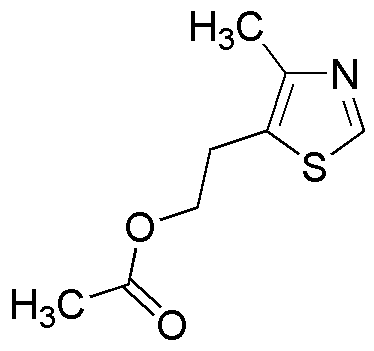2-(4-Methyl-5-thiazolyl)ethyl acetate is widely utilized in research focused on:
- Flavor and Fragrance Industry: This compound is used as a flavoring agent in food products and beverages, providing a unique taste profile that enhances consumer appeal.
- Pharmaceuticals: It serves as an intermediate in the synthesis of various pharmaceutical compounds, aiding in the development of new medications.
- Agricultural Chemicals: The chemical is employed in the formulation of pesticides and herbicides, contributing to effective crop protection strategies.
- Biochemical Research: Researchers utilize it in studies related to enzyme activity and metabolic pathways, helping to uncover important biological processes.
- Cosmetics: It is incorporated into cosmetic formulations for its potential skin benefits and as a fragrance component, enhancing product attractiveness.
General Information
Properties
Safety and Regulations
Applications
2-(4-Methyl-5-thiazolyl)ethyl acetate is widely utilized in research focused on:
- Flavor and Fragrance Industry: This compound is used as a flavoring agent in food products and beverages, providing a unique taste profile that enhances consumer appeal.
- Pharmaceuticals: It serves as an intermediate in the synthesis of various pharmaceutical compounds, aiding in the development of new medications.
- Agricultural Chemicals: The chemical is employed in the formulation of pesticides and herbicides, contributing to effective crop protection strategies.
- Biochemical Research: Researchers utilize it in studies related to enzyme activity and metabolic pathways, helping to uncover important biological processes.
- Cosmetics: It is incorporated into cosmetic formulations for its potential skin benefits and as a fragrance component, enhancing product attractiveness.
Documents
Safety Data Sheets (SDS)
The SDS provides comprehensive safety information on handling, storage, and disposal of the product.
Product Specification (PS)
The PS provides a comprehensive breakdown of the product’s properties, including chemical composition, physical state, purity, and storage requirements. It also details acceptable quality ranges and the product's intended applications.
Certificates of Analysis (COA)
Search for Certificates of Analysis (COA) by entering the products Lot Number. Lot and Batch Numbers can be found on a product’s label following the words ‘Lot’ or ‘Batch’.
*Catalog Number
*Lot Number
Certificates Of Origin (COO)
This COO confirms the country where the product was manufactured, and also details the materials and components used in it and whether it is derived from natural, synthetic, or other specific sources. This certificate may be required for customs, trade, and regulatory compliance.
*Catalog Number
*Lot Number
Safety Data Sheets (SDS)
The SDS provides comprehensive safety information on handling, storage, and disposal of the product.
DownloadProduct Specification (PS)
The PS provides a comprehensive breakdown of the product’s properties, including chemical composition, physical state, purity, and storage requirements. It also details acceptable quality ranges and the product's intended applications.
DownloadCertificates of Analysis (COA)
Search for Certificates of Analysis (COA) by entering the products Lot Number. Lot and Batch Numbers can be found on a product’s label following the words ‘Lot’ or ‘Batch’.
*Catalog Number
*Lot Number
Certificates Of Origin (COO)
This COO confirms the country where the product was manufactured, and also details the materials and components used in it and whether it is derived from natural, synthetic, or other specific sources. This certificate may be required for customs, trade, and regulatory compliance.


